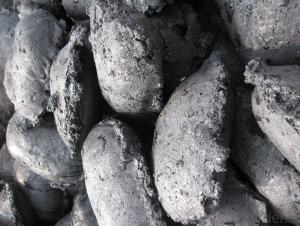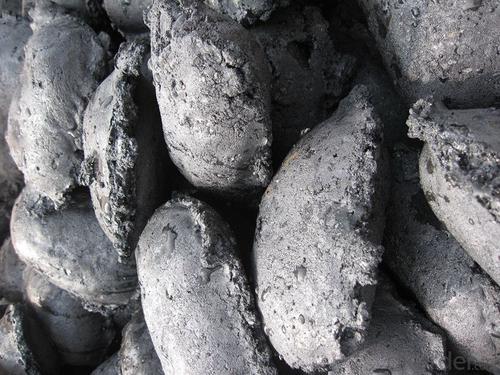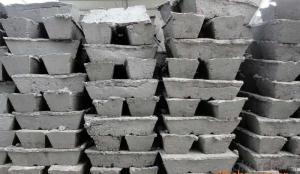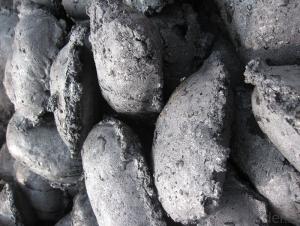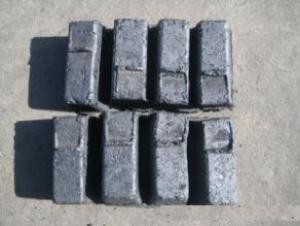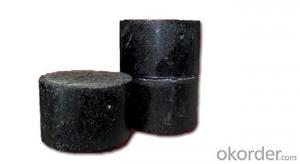Carbon Electrode Paste Block with Low Ash
- Loading Port:
- Lianyungang
- Payment Terms:
- TT OR LC
- Min Order Qty:
- 20 m.t.
- Supply Capability:
- 1000 m.t./month
OKorder Service Pledge
OKorder Financial Service
You Might Also Like
Spcifications
Carbon Electrode Paste Block with Low Ash
1:carbon eletrode paste
2:for ferroalloy,calcium carbide manufacture
3:HS 3801300000,YB/T5212-1996,ISO9001:2008
Product Description
Carbon Electrode Paste Block with Low Ash
Carbon Electrode Paste is a self-baking electrode used in submerged arc furnaces for delivering power to the charge mix. Electrode Paste is added to the top of the electrode column in either cylindrical or briquette form. As the paste moves down the electrode column the temperature increase causes the paste to melt and subsequently bake forming a block of electrically conductive carbon. Electrode Paste is essentially a mix of Electrically Calcined Anthracite (ECA) or Calcined Petroleum Coke (CPC) with Coal Tar Pitch.
Product Feature
Carbon Electrode Paste Block with Low Ash
Graphite/Carbon Electrode Paste
Specification/Item
Ash 4.0%max5.0%max 6.0%max7.0% Max9.0% Max11.0% Max
VM 12.0%-15.5%12.0%-15.5%12.0%-15.5%9.5.0%-13.5%11.5%-15.5%11.5%-15.5%
Strength
Compress 18.0Mpa Min17.0Mpa Min15.7Mpa Min19.6Mpa Min19.6Mpa Min19.6Mpa Min
Specific 65μΩm Max68μΩm Max75μΩm Max80μΩm Max90μΩm Max90μΩm Max
Resistance
Bulk Density1.38G/CM3 Min1.38G/CM3 Min1.38G/CM3 Min1.38G/CM3 Min1.38G/CM3 Min1.38G/CM3 Min
Product Image
Carbon Electrode Paste Block with Low Ash
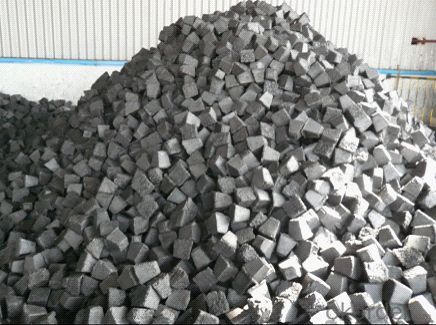
Advantage:
Carbon Electrode Paste Block with Low Ash
1.High quality and competitive price.
2.Timely delivery.
3.If any item you like. Please contact us.
Your sincere inquiries are typically answered within 24 hours.
- Q: Does alumina react with carbon?
- NotThe smelting of Al in industry can only be done by electrolysis. Even at high temperatures, the reducibility of C is not as strong as Al, and the melting point of Al2O3 is very high. At this temperature, C has been gasified
- Q: How does carbon affect the formation of tsunamis?
- The formation of tsunamis is not directly influenced by carbon. Tsunamis primarily occur as a result of underwater earthquakes, volcanic eruptions, or landslides. Carbon, in the form of carbon dioxide (CO2), is a greenhouse gas that contributes to global warming and climate change. Although carbon emissions and the resulting climate change can affect ocean temperatures and sea levels, they do not directly cause tsunamis. However, it is important to consider that climate change can indirectly impact the intensity and frequency of natural disasters, including tsunamis, by affecting oceanic and atmospheric conditions. The rising sea levels caused by melting glaciers and polar ice can potentially increase the destructive power of tsunamis by enabling them to reach further inland. Moreover, climate change can influence the occurrence and strength of earthquakes and volcanic activity, which are the main triggers of tsunamis. Therefore, even though carbon emissions do not directly influence the formation of tsunamis, their impact on climate change can indirectly affect the factors that contribute to the development and severity of tsunamis.
- Q: How is carbon used in the agricultural industry?
- Various purposes in the agricultural industry make carbon widely used. One of its main uses in agriculture is as a soil amendment. The addition of carbon-rich organic matter, like compost or manure, improves soil structure, fertility, and overall health. This occurs because carbon increases the soil's capacity to retain moisture, nutrients, and beneficial microorganisms, all of which are vital for plant growth. In addition to soil amendment, carbon is also utilized in the form of carbon dioxide (CO2) for greenhouse enrichment. In controlled environments such as greenhouses, plants require higher concentrations of CO2 to enhance growth and productivity. Carbon dioxide is introduced into the greenhouse to maintain optimal levels, facilitating photosynthesis and accelerating plant growth. Furthermore, carbon-based fertilizers are commonly employed in agriculture. Fertilizers like urea or ammonium nitrate provide essential nutrients to crops and enhance productivity. Carbon serves as a crucial component in these fertilizers, aiding in the controlled release and effective uptake of nutrients by plants. Moreover, carbon is employed in the production of pesticides and herbicides. Many of these agricultural chemicals contain carbon compounds specifically designed to target and control pests, diseases, and weeds that can harm crops. Carbon-based chemicals are preferred due to their effectiveness and ability to naturally break down without causing long-term harm to the environment. In summary, carbon plays a vital role in the agricultural industry by enhancing soil fertility, promoting plant growth, and aiding in pest control. Its versatility makes it an indispensable resource for sustainable and efficient farming practices.
- Q: What are fossil fuels and how are they formed?
- Fossil fuels are natural resources that are formed from the remains of ancient plants and animals. They are non-renewable sources of energy that have been used by humans for centuries. The three main types of fossil fuels are coal, oil, and natural gas. The formation of fossil fuels begins with the organic matter that comes from plants and animals. Over millions of years, this organic matter becomes buried deep within the Earth's crust. The process of fossilization occurs as layers of sediment build up over time, putting pressure and heat on the organic matter. In the case of coal, the organic matter is mostly plant material that has been compacted and heated over time. As the pressure and temperature increase, the plant material undergoes a chemical transformation, gradually turning into coal. The formation of oil and natural gas is slightly different. It starts with the remains of tiny marine microorganisms, such as plankton, that have settled at the bottom of ancient oceans. Over time, these organic materials become buried under layers of sediment and are subjected to immense heat and pressure. Under these conditions, the organic matter gets transformed into a mixture of hydrocarbons, which is the main component of oil and natural gas. The oil and gas then migrate through porous rocks until they are trapped by impermeable layers, forming oil or gas reservoirs. Overall, the formation of fossil fuels is a slow geological process that takes millions of years. It requires specific conditions of heat, pressure, and burial to convert the organic matter into coal, oil, or natural gas. Due to their limited availability and the environmental impact of their combustion, there is an increasing focus on transitioning to renewable energy sources as a more sustainable alternative.
- Q: Why carbon fiber resistant to low temperature
- Therefore, the carbon fiber composite core can be used in the design and manufacture of transmission carriers under extremely cold conditions, such as Antarctic research and research.
- Q: DNF new advanced furnace rock carbon reinforcement +10 50 powder weapons, the upper 11 probability of success is how much, how many advanced furnace rock carbon?
- Seemingly increased only 3.39 small, if we can make the cost of reaching the 80% chance of strengthening, so strengthen the probability of using advanced carbon can reach 88%. Why do you say that? First of all, let's make sure that the random ones in the game are fake. No matter what, random in the game is not real, but computer controlled pseudo random. There are two pseudo random, I simply explain. One is to simulate the real random situation, such as the weather forecast by computer simulation, in this case the random also is not true, because we had already entered the specific results, no matter how the computer is random, will have sun or rain and thunder like, the computer can not simulate the RMB under the sky the weather, because the program did not give it such a result, so although it seems very real, is actually false, is pseudo random. The other is random, which contains certain specific rules, which are widely used in competitive games, which is what we usually call the reinforcement probability. The reinforcement rate is 28%, with fixed values, but it is also controlled by the program and is pseudorandom. The reinforcement of odds is not what we imagine, but the effect of seeing Kylie's sister's feelings, whether successful or not, affects the chances of the next reinforcement. In this case, each reinforcement is not an independent event because it is affected by what happened before, and for each of the truly random or previous pseudo random events, each should be an independent event. Take random hits in the game as an example.
- Q: What is carbon nanocomposite?
- Carbon nanocomposite refers to a material that is made up of carbon nanoparticles embedded in a matrix material. This combination results in a material that exhibits enhanced mechanical, thermal, and electrical properties, making it suitable for a wide range of applications such as aerospace, electronics, and energy storage.
- Q: What are the consequences of increased carbon emissions on tourism industry?
- Increased carbon emissions have significant consequences on the tourism industry. One of the most prominent effects is the deterioration of natural landscapes and ecosystems that attract tourists. Carbon emissions contribute to global warming, resulting in rising temperatures, melting glaciers, and increased instances of extreme weather events like hurricanes and droughts. These environmental changes can lead to the destruction of iconic landmarks, such as coral reefs or national parks, which are often the main attractions for tourists. Furthermore, increased carbon emissions contribute to air pollution, which can negatively impact air quality in popular tourist destinations. Poor air quality can lead to respiratory issues and other health problems for both tourists and local populations, making these places less desirable to visit. Additionally, the degradation of natural environments due to carbon emissions can also affect wildlife, leading to a decline in biodiversity. This loss of wildlife can reduce the appeal of ecotourism destinations, which heavily rely on the presence of diverse flora and fauna. Moreover, the tourism industry heavily relies on transportation, which is a significant source of carbon emissions. The use of fossil fuels in planes, ships, and cars contributes to the overall carbon footprint of the industry. As countries strive to reduce their carbon emissions, they may impose stricter regulations or taxes on air travel, making it more expensive and less accessible for travelers. This can impact the number of tourists visiting different destinations and hinder the growth of the tourism industry. Lastly, the consequences of increased carbon emissions extend beyond environmental factors. Climate change and extreme weather events can disrupt travel plans, leading to cancellations and financial losses for both tourists and businesses in the tourism industry. Moreover, destinations that heavily rely on winter tourism, such as ski resorts, may face challenges due to shorter snow seasons or inconsistent snowfall patterns caused by climate change. In conclusion, increased carbon emissions have severe consequences on the tourism industry. From the degradation of natural landscapes and ecosystems to the impact on air quality and wildlife, the effects of carbon emissions can deter tourists from visiting certain destinations. Additionally, the reliance of the tourism industry on transportation contributes to its overall carbon footprint, potentially leading to increased costs and reduced accessibility for travelers. Climate change-related disruptions and financial losses further compound the challenges faced by the tourism industry.
- Q: What are the problems that should be paid attention to in the injection molding of the material? Who has some details about carbon fiber injection? Thank you for sharing
- Carbon fiber melting point at about 3000 degrees (isolation oxygen, oxygen, about 400 degrees will be oxidized), itself can not be injection processing, only carbon fiber filled plastic can be injection molding.
- Q: How are carbon nanotubes produced?
- Carbon nanotubes are typically produced through a process called chemical vapor deposition (CVD), where a carbon-containing gas is introduced into a high-temperature reactor. Under controlled conditions, the carbon atoms assemble and form nanotubes on a catalyst surface, such as iron or nickel. Other methods, including arc discharge and laser ablation, can also be used to produce carbon nanotubes.
Send your message to us
Carbon Electrode Paste Block with Low Ash
- Loading Port:
- Lianyungang
- Payment Terms:
- TT OR LC
- Min Order Qty:
- 20 m.t.
- Supply Capability:
- 1000 m.t./month
OKorder Service Pledge
OKorder Financial Service
Similar products
Hot products
Hot Searches
Related keywords

